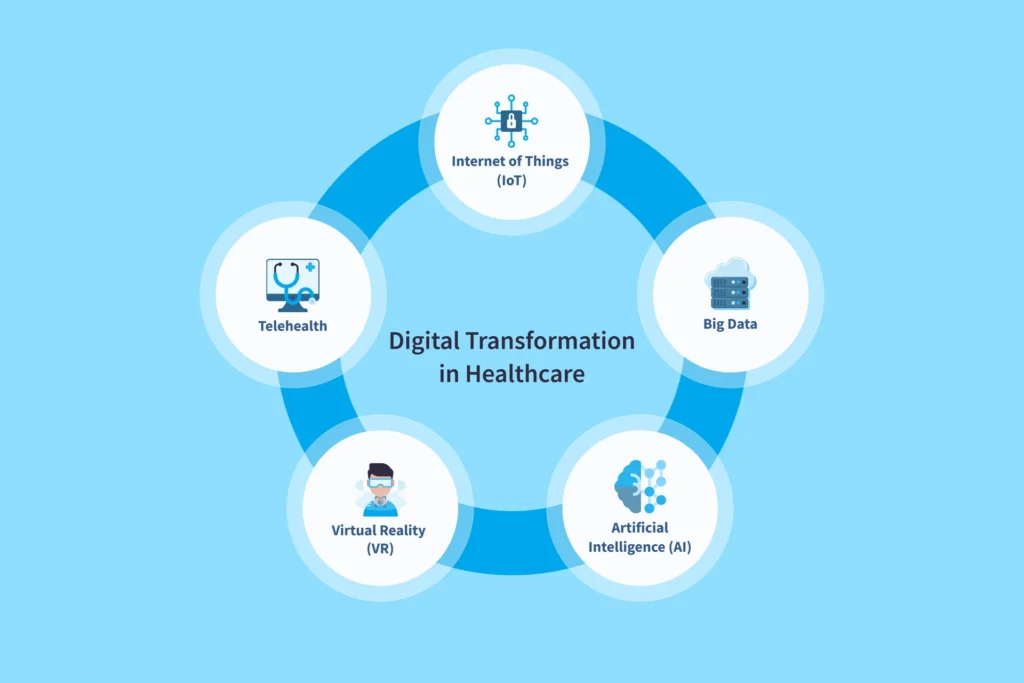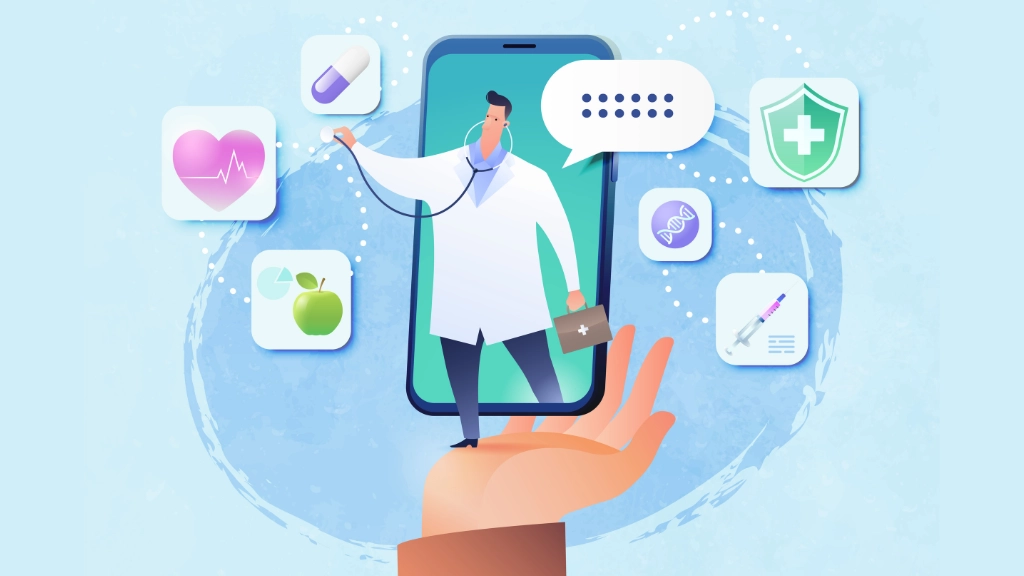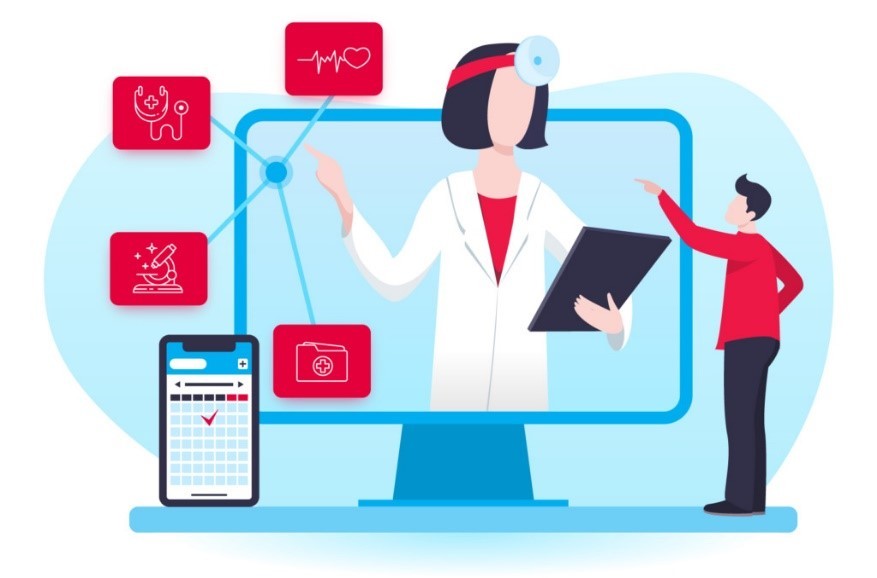Introduction
The U.S. healthcare industry is undergoing a digital revolution, leveraging advanced technologies to enhance patient care, streamline operations, and reduce costs. As the sector faces challenges such as rising costs, a growing aging population, and increasing demand for personalized care, digital transformation is becoming essential. From telehealth to AI-powered diagnostics and electronic health records (EHRs), digital tools are reshaping the landscape, offering unprecedented opportunities for innovation and efficiency.

What is the Future of Digital Healthcare?
The future of digital healthcare is promising, with technologies evolving rapidly to improve patient outcomes and operational efficiency. Several trends are defining this future:
- Telehealth and Remote Patient Monitoring: Telehealth services surged during the COVID-19 pandemic, highlighting the convenience and effectiveness of remote care. Future digital healthcare will integrate telehealth solutions with wearable devices for continuous patient monitoring, making U.S healthcare more accessible and personalized.
- Artificial Intelligence (AI) and Machine Learning (ML): AI and ML are revolutionizing diagnostics, treatment planning, and patient care. Predictive analytics driven by AI can identify potential health risks before they become critical, enabling proactive care. For example, AI algorithms can analyze medical images more accurately and faster than human radiologists, improving diagnostic accuracy.
- Blockchain for Secure Data Management: With the increase in digital healthcare solutions comes the need for secure and interoperable data systems. Blockchain technology offers a secure way to manage patient data, ensuring privacy and compliance with regulations like HIPAA while facilitating seamless data sharing among healthcare providers.
- Virtual Reality (VR) and Augmented Reality (AR): These technologies are being used for pain management, physical therapy, and even in medical training. VR can create immersive experiences that help patients manage pain or anxiety, while AR can assist surgeons during complex procedures by overlaying critical information on the surgical field.
- Wearable Devices and IoT in Healthcare: The Internet of Things (IoT) is expanding its footprint in healthcare through wearable devices that monitor vital signs, physical activity, and sleep patterns. These devices offer real-time data, enabling continuous patient monitoring and timely interventions.

How is Digital Transformation Changing the U.S. Healthcare Industry?
Digital transformation is fundamentally changing how healthcare is delivered, managed, and experienced. Here are some key ways it’s transforming the industry:
- Enhanced Patient Engagement: Digital platforms enable patients to access their health records, schedule appointments, and communicate with healthcare providers easily. Mobile health apps provide personalized health advice, medication reminders, and more, encouraging proactive patient participation in their healthcare journey.
- Improved Efficiency and Cost Reduction: Automation of administrative tasks such as appointment scheduling, billing, and claims processing reduces operational costs and minimizes human error. AI-powered chatbots can handle routine patient inquiries, freeing up healthcare staff for more complex tasks.
- Data-Driven Decision Making: The integration of big data analytics in healthcare allows for better decision-making. By analyzing patient data, U.S. healthcare providers can identify trends, optimize treatment plans, and predict disease outbreaks. This data-driven approach enhances both patient outcomes and operational efficiency.
- Personalized Medicine: Advances in genomics and digital tools enable personalized treatment plans tailored to an individual’s genetic makeup. Precision medicine is becoming more achievable with digital health tools, offering targeted therapies that improve efficacy and reduce side effects.
- Interoperability and Collaboration: Digital transformation promotes better collaboration among healthcare providers through interoperable systems. Electronic Health Records (EHRs) allow seamless sharing of patient information, improving coordination and continuity of care across different healthcare settings.

Case Studies: Real-World Examples of Digital Transformation in U.S. Healthcare
- Cleveland Clinic’s Virtual Second Opinions: Cleveland Clinic launched its virtual second opinion program, leveraging digital platforms to offer expert medical consultations to patients worldwide. The program uses telemedicine to connect patients with specialists, reducing the need for physical travel and providing access to world-class care from the comfort of home. This initiative highlights how digital health can break down geographical barriers and make specialized care more accessible.
- Kaiser Permanente’s EHR System: Kaiser Permanente has successfully implemented a comprehensive EHR system across its healthcare network. The system integrates patient records, allowing healthcare providers to access and update patient information in real-time. This digital transformation initiative has improved care coordination, reduced medical errors, and enhanced patient safety. It serves as a model for other healthcare organizations looking to streamline operations through digital technology.
- Mayo Clinic’s AI-Powered Diagnostics: Mayo Clinic has embraced AI to enhance diagnostic accuracy and speed. By partnering with tech companies, Mayo Clinic has developed AI algorithms capable of analyzing medical images and detecting abnormalities. This technology has significantly reduced the time required for diagnosis and improved patient outcomes by enabling earlier and more accurate detection of diseases.
- Providence St. Joseph Health’s Telehealth Expansion: Providence St. Joseph Health has expanded its telehealth services to provide remote care to patients, particularly in underserved areas. The use of telemedicine has increased access to healthcare services, reduced the need for in-person visits, and ensured continuity of care during the COVID-19 pandemic. This case study demonstrates the scalability and effectiveness of telehealth as part of digital healthcare transformation.

How Big is the U.S. Healthcare in Digital Market?
The U.S. digital health market is experiencing rapid growth, driven by increasing demand for innovative healthcare solutions and the widespread adoption of digital technologies. Here’s an overview of the market size and growth projections:
- Market Size: As of 2023, the U.S. healthcare market was valued at approximately $150 billion. This includes various segments such as telehealth, mobile health apps, wearable devices, and health IT systems.
- Growth Projections: The market is expected to grow at a compound annual growth rate (CAGR) of around 15% from 2024 to 2030, reaching an estimated value of over $350 billion by the end of the decade. Factors contributing to this growth include the aging population, rising prevalence of chronic diseases, increasing consumer demand for personalized healthcare, and government initiatives supporting digital health adoption.
- Investment Trends: Venture capital investments in digital health startups have been robust, with billions of dollars flowing into the sector annually. Key areas of investment include telehealth platforms, AI-driven healthcare solutions, and health data analytics.
Conclusion
The U.S. healthcare industry is racing toward a digital future, with innovations in telehealth, AI, wearable devices, and data analytics paving the way. Digital transformation is not only improving patient care and engagement but also driving operational efficiencies and reducing costs. As the market continues to grow, healthcare providers must embrace digital strategies to stay competitive and meet the evolving needs of patients.
With ongoing advancements in technology and increasing investment in digital health solutions, the future of U.S. healthcare looks brighter and more innovative than ever. By adopting these digital trends, healthcare organizations can enhance patient outcomes, improve access to care, and create a more efficient and sustainable healthcare ecosystem.